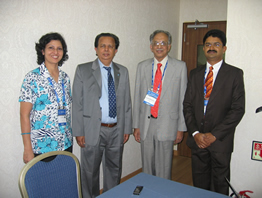Interview with Dr. Madhavan Nair, ISRO Chairman at the time
The APRSAF secretariat conducted an interview with Dr. Madhavan Nair, Chairman of the Indian Space Research Organisation (at the time) on the occasion of the IAC2009 held from 12 to 16 October 2009, in Daejeon, Republic of Korea. Excerpts of the Interview are given below.


Mission to the moon
Our recent achievement is the maiden mission to the moon, the Chandrayaan-1. A spacecraft with 11 instruments was launched into lunar orbit, whereupon it mapped the lunar surface, collected details about the features, mineral content, chemical composition and so on. Though this mission lasted for about 300 days, the detailed analysis of data led to a major discovery, namely, the presence of water molecules on the surface of the moon, especially near the pole. Of course the quantity of water found is very small; an average of 600 ppm. However, this was the first time that such positive information on the presence of water on the moon had been found. This was a joint finding between NASA and ISRO. This moon mission had 5 international payloads from USA and Europe in addition to 6 instruments from India.
Oceansat-2
We recently had another launch of the earth observation satellite called Oceansat-2. It incorporated an Ocean Colour Monitor, which will provide information on potential fishing zones for fishermen to go for catches and a scatterometer, which measures winds on the ocean surface and the roughness of the seas. The third instrument is a Radio Occultation Sounder for Atmospheric Studies that will study the atmospheric moisture and the temperature profile.
Future plans
We are preparing for the launch for GSLV with an indigenous Cryogenic Stage, which has many technological challenges. It works on a stage combustion cycle; developing a thrust of about 7.5 t in a vacuum. The launch is scheduled to take place within the next few months. With that, we will also become self-reliant in our geostationary launch vehicle programme.
Space education programme
There are two elements.
One is harnessing the space communication capability to take education to the remote parts in the country, known as tele-education. We have a satellite launched for this purpose, named EDUSAT, which is used by more than 30,000 schools located in remote areas. It provides an opportunity to learn from experts for those living in faraway places, where access to quality education is non-existent or very limited. This has become a very successful programme.
The second one is, as part of the human resource development programme for space, we have established an institute called the Indian Institute of Space Science and Technology, IIST in short. This institute takes school leavers and provides them with specialized training on the subject which is relevant for ISRO. At the end of the programme, they are absorbed into ISRO. We believe that we can be a very powerful and motivated team in future to progress further with ISRO.
STAR program
This is a very useful program between the Japanese Space Agency and the other Asian Space organizations, intended to provide space technology and the benefits thereof to the Asia-Pacific region. This has taken off very well and we are delighted with the cooperation involved.
We are making our experts available to impart training to those from this region who are involved in this program. I am sure this program can contribute in many areas such as satellite building, instrument building, or even more, the application of space resources for societal development.
Sentinel Asia
As you know, there are a lot of natural disasters in the Asia region, such as cyclones, heavy rains and earthquakes. The earth observation images from our satellites could be made available in such cases.
More than that, we can contribute by creating a database to identify disaster prone areas and guide decision makers to identify one of the nearest safer zones to where people can be moved in the event of disaster. All these could be done together in an integrated manner. The initial phase of the program has been positive and whenever a disaster has occurred, we as space agencies have joined in providing the required information to the respective countries.
Of course this could be integrated with a global system such as the International Charter on Space and Major Disaster as well as the initiative adopted by the UN, called SPIDER. We have to synergize the collective force of all these agencies to tackle disasters more effectively.
Other APRSAF WGs
Although we commenced with the example of natural disasters, we must move beyond this area. In fact, I discussed with Dr. Tachikawa, JAXA President, yesterday, and we have come to an agreement to examine the atmosphere, climate change concerns, clean energy sources and so on, meaning it is becoming a new theme for the future. We must ensure a synchronization of forces among the various space agencies so that we can utilize space resources in a complementary manner in order to tackle issues of climate change.